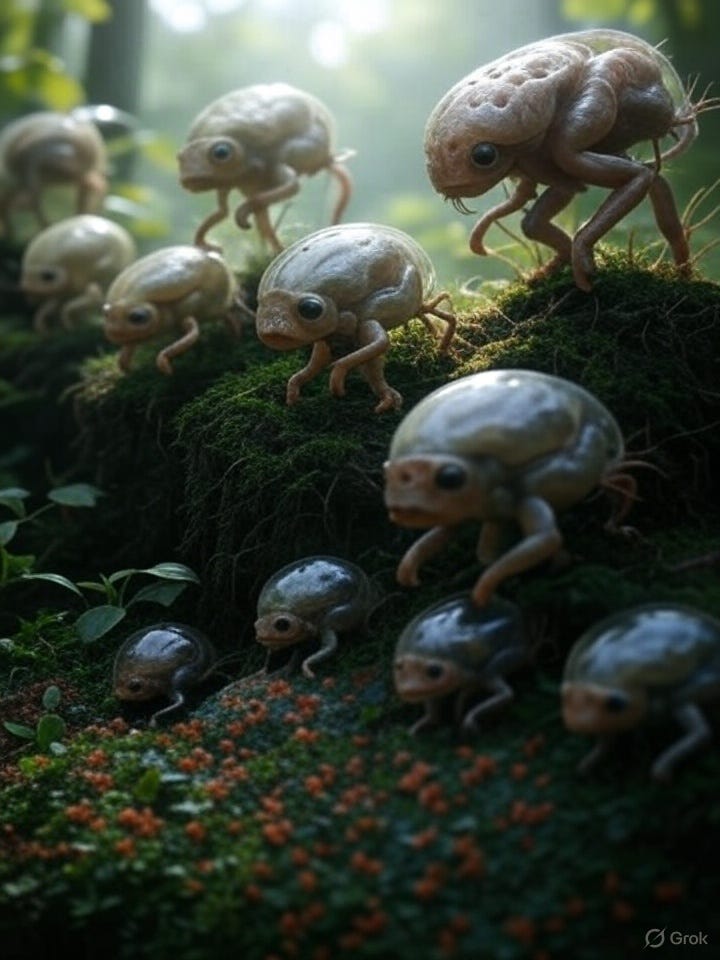Risk & Progress| A hub for essays that explore risk, human progress, and your potential. My mission is to educate, inspire, and invest in concepts that promote a better future. Subscriptions are free, paid subscribers gain access to the full archive, including the Pathways of Progress and Realize essay series.
The Big Bang gave us energy and the laws of physics, but how did it lead to life and eventually, modern civilization? It turns out, the Big Bang also kicked off an evolutionary process that continues to this very day. In pursuit of ever higher entropy, the universe found a universal “algorithm” that discovers knowledge and creates more complex forms. What began with chemical evolution, the mixing and melding of atoms in stellar furnaces, gave way to biological evolution, and then to cultural evolution among the human species. With each step upward along the rungs of this evolutionary ladder, knowledge discovery and transmission accelerated as energy usage changed.
Differentiate, Select, Amplify
In his book, “Energy: Engine of Evolution,” Frank Niele argues that the dominant view, that natural selection drives evolution, is wrong. Instead, he suggests that energy is the driving force of evolution, and natural selection is merely a shaping force. This parallels my thesis that all progress is a function of energy and knowledge. Life evolves because it is in an endless search to learn how it can best dissipate energy and increase the universe’s entropy. Niele divides the history of life into six distinct “energy periods.” The boundaries between these periods are marked by a significant shift in the way energy is utilized:
The Termian period: The beginning of cellular metabolism.
The Photian period: The beginning of photosynthesis.
The Oxian period: The beginning of oxygen combustion of carbohydrates.
The Pyrian period: The human domestication of fire.
The Agrian period: Otherwise known as the “Agricultural Revolution.”
The Carbian period: Also known as the “Industrial Revolution.”
We now understand that life formed on Earth’s early oceans about 4 billion years ago. As I discussed, the “primordial soup” was likely a mix of carbon-rich molecules, stirred and churned under the heat of direct sunlight. Life arose in these conditions because it could dissipate energy more effectively than simple matter. This follows the Second Law of Thermodynamics, which states that energy in the universe must tend toward dissipation. Life can reduce entropy locally by taking in energy, but when doing so, it raises the entropy of the universe around it. Life does this using knowledge acquired through the process of evolution.
In his book, “The Origin of Wealth,” author Eric D. Beinhocker breaks the evolutionary process into three distinct steps: Differentiate, Select, and Amplify. Evolution, as he describes it, is a trial-and-error “algorithm” that tries new things, does what works, and stops doing what doesn’t work. This process is recursive, with the outputs from one round of evolution serving as the inputs of the next. Evolution is mass, parallel, continuous, and incremental experimentation. It’s a knowledge discovery mechanism; a learning algorithm that discovers knowledge and, in the case of life, encodes that knowledge onto DNA, before amplifying it through replication (reproduction).
Life began in the “Termain period” about 4 billion years ago. Early organisms were prokaryotic, small and simple cells that lacked organelles or distinct nuclei. The lack of specialization and structure limited their size and capabilities. Nonetheless, they were hardy, and prokaryotes persist to this day. They were also numerous enough in Earth’s oceans that they changed the climate over millions of years. About 3.7 billion years ago, some of these species evolved to absorb sunlight energy directly and perform photosynthesis, marking the beginning of the Photian period. In the process, they released oxygen into the atmosphere, which until then had been mainly comprised of carbon dioxide.
Over 1 billion years after the emergence of prokaryotic life, or about 2.7 billion years ago, larger and more complex cells emerged. How this happened is not fully understood. Some believe that anaerobic prokaryotes, literally suffocating in the increasingly oxygen-rich atmosphere, evolved to survive by symbiotically living inside aerobic cells. Over time, their DNA co-mingled, and the two species became one. This endosymbiotic origin of larger, more complex cells is now generally accepted, if not proven, and marks the beginning of Niele’s Oxian period. These new organisms, or eukaryotic cells, developed distinct nuclei and organelles with specialized functions and were far more complex and capable than their ancestors.
Yet, the process of evolution was painfully slow. This is because the transmission of genetic information, the “input” knowledge into evolution’s algorithm, was limited. Early life replicated or cloned itself, and there were only two ways to evolve adaptations: Horizontal Gene Transfer (HTG) and mutation. Through HTG, some organisms could transfer beneficial genetic information horizontally between member of their species. Mutation, on the other hand, had to wait for fortuitous “errors” to emerge when copying genetic material between generations. If those “errors” were beneficial, they were passed on to subsequent generations. If not, then the mutation was swept from the gene pool.
Up to 2.0 billion years ago, through a complex and murky process of trial and error, evolution discovered a superior mechanism: sexual reproduction. In this process, advantageous genetic information could be passed from one generation to the next by combining the DNA of two members of the species. Through this recombination, bad mutations could be swept out of the gene pool more quickly, and the mixing and matching of DNA made it more probable that advantageous traits would appear than by random chance alone. In other words, life found a way to discover and disseminate knowledge more quickly across generations.
Nevertheless, these organisms remained unicellular, limited in both size and capability. Cells are bound to the “square-cube law,” which holds that as an object grows larger, its internal volume grows at a cubic rate while its surface area grows at a square rate. For a cell, the surrounding membrane, the window through which it must acquire nutrients, energy, and dispose of waste, cannot grow as fast as its internal area. Past a certain size, the cell’s surface-to-area ratio becomes insufficient to maintain homeostasis. It took evolution several hundred million more years (though the exact timing is debated) to find a path around the square-cube law by combining many cells into a more complex organism.
Some segments of cells eventually evolved to specialize and develop specific functions. Just as the specialization of organelles within eukaryotic cells expanded their size and capability, specialization between cells created a whole greater than the sum of its parts. The result was the first plants. Another key evolutionary innovation was the shift from “bags” to “tubes.” Until about 600 million years ago, organisms were akin to “bags” with a single orifice that took in nutrients and expelled waste. Tubular bodies were better suited for movement and allowed for more efficient digestion, supporting larger organisms. This basic tubular architecture, where food goes in one end and waste comes out the other, forms the basic structure of complex organisms, including humans.
When carrying out “evolution’s algorithm,” organisms became increasingly diverse and complex as their constituent parts became more specialized, distinct, and ordered. Some cells became sensitive to light, forming eyes. Some developed the ability to move, becoming muscles. While others formed neural connections that take in electrical data from other cells and use this information to solve problems, resembling early biological computers. Remember, natural selection tells us how this happened, but the driving force, the why, is physics; it’s all energy dissipation. This process continues to this day, albeit in a much accelerated fashion.
You also may like…








Nice posting exploring some subtle ideas. Mostly encapsulated when you say:
"Evolution, as he describes it, is a trial-and-error “algorithm” that tries new things, does what works, and stops doing what doesn’t work. This process is recursive, with the outputs from one round of evolution serving as the inputs of the next. Evolution is mass, parallel, continuous, and incremental experimentation. It’s a knowledge discovery mechanism; a learning algorithm that discovers knowledge ..."
But our language is sometimes distorting or misaligning our real meaning.
A feature of evolution that I find useful to keep emphasizing is that it is a passive process, not an actively directed (or teleological) one. The wording "trial and error" and "tries new things" can be (too often) misconstrued to be directed towards a "better" solution. Words like "recursive", "continuous", "incremental", and "discovery" might also add to this kind of interpretation.
I think it might be better to say that the "algorithm" is the physical law(s) [2nd Law of thermo] that causes nature to seek a reduction in free energy (and a corresponding increase in entropy). But for most chemistry (and biochemistry in particular) it appears the goal of fully dissipating free energy is (temporarily) halted when a "mid-level" equilibrium state is found with a given set of chemical bonds, etc. Thus "life force" energy is used to create complex organic and biochemical molecules before they are fully broken down into constituent atoms. That energy is then dissipated outside that system (as you indicate).
The trial aspect is (almost?) always random, from the local availability of the necessary atoms to complete a given reaction, or the genetic changes in DNA, RNA, or selected proteins from cosmic rays or other radiation of chemical disturbances. Then the "error" part takes over and the result is the achieving (or not achieving) additional replication at the molecular level, or reproduction at the cellular and higher levels of tissues and organisms.
I like your citing the aspect of "knowledge" as it is an analog at the molecular level of the insight I obtained during the manufacturing engineering portion of my career: manufacturing is essentially the application of information to the manipulation of materials to make the goods being produced. But the word "discovery" also has the flavor of "invention", and invention implies a designer, and a goal directed aim or activity. [There was a recent discussion somewhere asking if mathematics was discovered or invented :-) .] Perhaps we should say it is a "testing" mechanism and then those solutions that pass "the test" are "discovered" to work better than those that do not.
Finally, I had never learned or forgotten that the transition from prokaryotes to eukaryotes might have involved the protections of an anaerobic environment as the atmosphere oxygenated. Thanks for that item, too.
I often copy web page essays into MS Word so I can highlight and comment on them, plus keep them in a semi-organized location for later reference. I usually use a previously saved essay as an MS Word format template, erasing the older content and replacing it with the more recently captured material (hopefully saved with a new file name!! sometimes I forget!! :-( ).
Doing that for this essay, I found a prior essay about evolutionary drift (from 1993!) and thought perhaps you and your readers would like to also examine it:
http://www.talkorigins.org/faqs/genetic-drift.html [link still available]
Random Genetic Drift Copyright © 1993-1997 by Laurence Moran [Last Update: January 22, 1993]
He suggests that in the mix of evolutionary mechanisms between natural selection and drift, it is looking like drift might be the more dominant or frequent mode of genomic and phenotype change. He discusses four factors that promote the drift mechanism over selection.